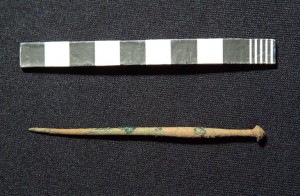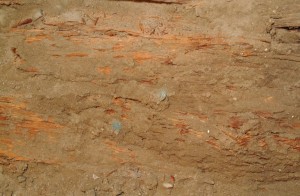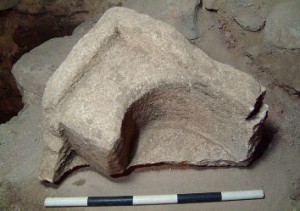During the 2006 archaeological dig in the former East Kirk a great many burials were uncovered. Some were complete, intact burials, whilst others were incomplete – disarticulated is the term used by archaeologists. That many burials were found should not be a surprise since most of the ground excavated had, in earlier times, been part of the graveyard and was incorporated into the church as it expanded. All the remains have been studied in close detail and a great deal has been learned about the life that these people from the past (roughly 1200 to 1700) lived. However, this post is more about the actual burials.

The majority of burials were carried out using either a linen shroud or a wooden coffin – the former was less expensive than the latter. No actual shrouds were found because the vegetable material used to make the cloth had decomposed over the centuries, but copper alloy pins (see photograph) which held the shroud in place were found in abundance and there was some stitching which might have come from a shroud. The wood used in coffins was more resistant to decomposition, so some wooden coffins were found, although many of them had collapsed. Metal fittings were also found from many of them. In some, coins were embedded in the wood (see photograph), which helps the archaeologists to date them.

In addition there were a number of simple stone cists holding burials of babies around the early apse. Not far away there was an example of a log burial. In this a tree had been split in two, roughly hollowed out and charred before using it to bury a young girl.
However, in times past other styles of burial were employed including using a stone sarcophagus. The word comes from the Greek and means ‘flesh eating’, because the stone, usually limestone, was thought to speed the decomposition of the corpse interred within it. Originally a sarcophagus was made of stone and carved out to take the body. Four broken parts of one of these was found during the dig, but it has not been accurately dated. The head and shoulder part is shown in the photograph. It is made of limestone – not a type of stone found near Aberdeen.

The history of the use of sarcophagi is a long one. In Roman times, they were placed against a wall and often had the three visible sides decorated with carvings. They continued to be used in Christian Europe, usually for important people such as royalty or leading churchmen. As they gradually became more elaborate they were placed in prominent positions in churches, frequently including a recumbent effigy on the lid. Plain sarcophagi were placed in crypts. As time passed, space became a problem inside churches. So a modified practice of having ‘false’ sarcophagi in the graveyard developed. These frequently appear as chest-like structures, sometimes with ornamentation, but below ground there was no traditional stone sarcophagus. Rather it used a traditional wooden, occasionally lead-lined, coffin burial with the above ground memorial indicating the social status of the deceased. Many examples of these can be seen in the St Nicholas Kirkyard. The term sarcophagus has been less widely used since the Renaissance and is now really only used as an archaeological term.
(The photographs are copyright Aberdeen Art Gallery & Museums Collections and are used with permission).